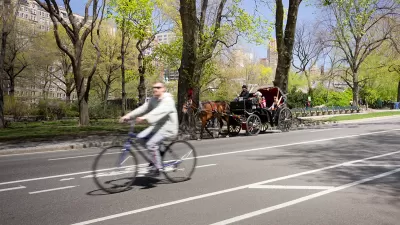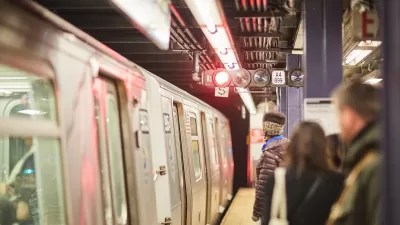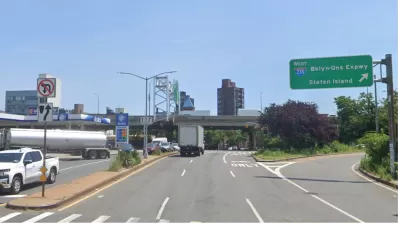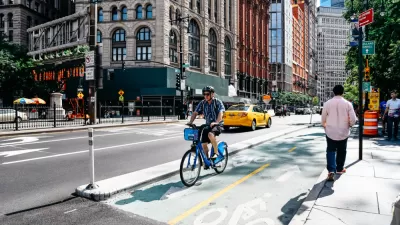A recent study by the New York City Department of Transportation on buffered bike lane interventions showed maintained traffic speeds while cyclist safety increased.

One of the biggest barriers to implementing bike lanes in certain municipalities is their perception of slowing down car traffic. However, according to a recent study by the New York City Department of Transportation reported on by Eric Jaffe at CityLab, these urban interventions actually did not reduce car speeds, but maintained them while increasing cyclist safety.
One of the interventions studied was the 2008 and 2009 Eighth Avenue bike lanes, between 23rd and 34th streets. According to Jaffe, before the treatment, "the avenue carried four travel lanes, one parking lane, one parking-rush hybrid, and an unprotected bike lane. Again, by narrowing the lanes, all five were preserved (though the hybrid became a parking lane) even as riders gained additional protection."
With the protected bike lanes in place with a buffer, DOT measured a 14 percent overall reduction in daytime travel times along the corridor. Similar results were found along many other corridors where protected bike lanes were created.
A DOT spokesperson shared with CityLab that another street redesign was adding left-turn pockets, contributing to the maintained traffic speeds. According to the spokesperson, originally, "cars turned left from a general traffic lane; in the new one, they merged into a left-turn slot beside the protected bike lane. This design has two key advantages: first, traffic doesn't have to slow down until the left turn is complete, and second, drivers have an easier time seeing bike riders coming up beside them."
FULL STORY: When Adding Bike Lanes Actually Reduces Traffic Delays

Alabama: Trump Terminates Settlements for Black Communities Harmed By Raw Sewage
Trump deemed the landmark civil rights agreement “illegal DEI and environmental justice policy.”

Planetizen Federal Action Tracker
A weekly monitor of how Trump’s orders and actions are impacting planners and planning in America.

The 120 Year Old Tiny Home Villages That Sheltered San Francisco’s Earthquake Refugees
More than a century ago, San Francisco mobilized to house thousands of residents displaced by the 1906 earthquake. Could their strategy offer a model for the present?

Opinion: California’s SB 79 Would Improve Housing Affordability and Transit Access
A proposed bill would legalize transit-oriented development statewide.

Record Temperatures Prompt Push for Environmental Justice Bills
Nevada legislators are proposing laws that would mandate heat mitigation measures to protect residents from the impacts of extreme heat.

Downtown Pittsburgh Set to Gain 1,300 New Housing Units
Pittsburgh’s office buildings, many of which date back to the early 20th century, are prime candidates for conversion to housing.
Urban Design for Planners 1: Software Tools
This six-course series explores essential urban design concepts using open source software and equips planners with the tools they need to participate fully in the urban design process.
Planning for Universal Design
Learn the tools for implementing Universal Design in planning regulations.
Clanton & Associates, Inc.
Jessamine County Fiscal Court
Institute for Housing and Urban Development Studies (IHS)
City of Grandview
Harvard GSD Executive Education
Toledo-Lucas County Plan Commissions
Salt Lake City
NYU Wagner Graduate School of Public Service





























